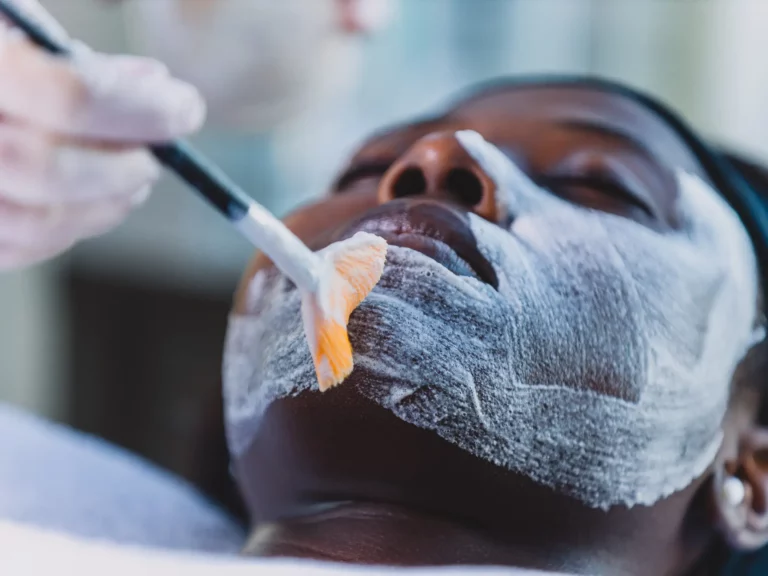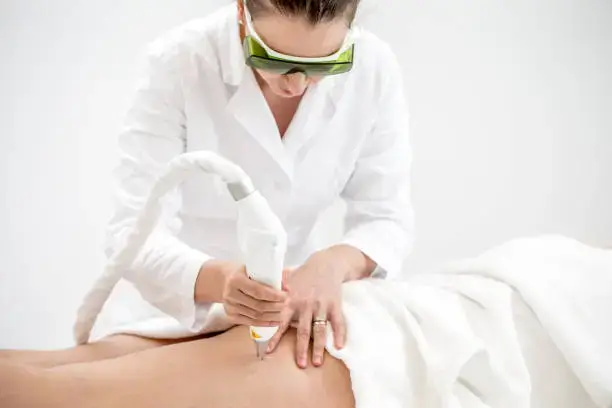Baby Acne Treatment: All You Need To Know
Are you wondering how to treat your baby’s acne without harming or risking their skin? Mavio got you covered in this article.
Acne is a common skin condition in babies that affect mostly newborns. Some are born with this acne or other skin reactions caused by hormonal imbalance like pimples and blemishes, which develops into acne in the first week. This acne has become a concern to parents and caregivers, bringing about this topic today.
Your baby’s skin is very delicate, so not every treatment is advisable. We have detailed this article to help you with your Baby’s Acne treatment.
Table of Contents
What is Baby Acne?

Baby acne can be described as those red or white bumps, either papule or Pastule or even both, that appear on a baby’s cheeks, nose, forehead or other parts of their body. They are differentiated into two types, Neonatal acne or newborn acne and Infantile acne.
Neonatal acne is a benign skin condition in newborns up to 3 months old. Some of this acne does not require treatment, and some fade away while some 20% prove stubborn.
Infantile acne is a skin condition that appears on babies older than 3 months and may seem larger than that of neonatal. This type of acne may not clear, just like neonatal acne, but instead proves more severe and requires treatment.
Baby acne is more common in male children than female children, but fortunately, it doesn’t harm your baby or discomfort them. It is important to note that baby acne differs from adult and young people’s.
What does baby acne looks like?
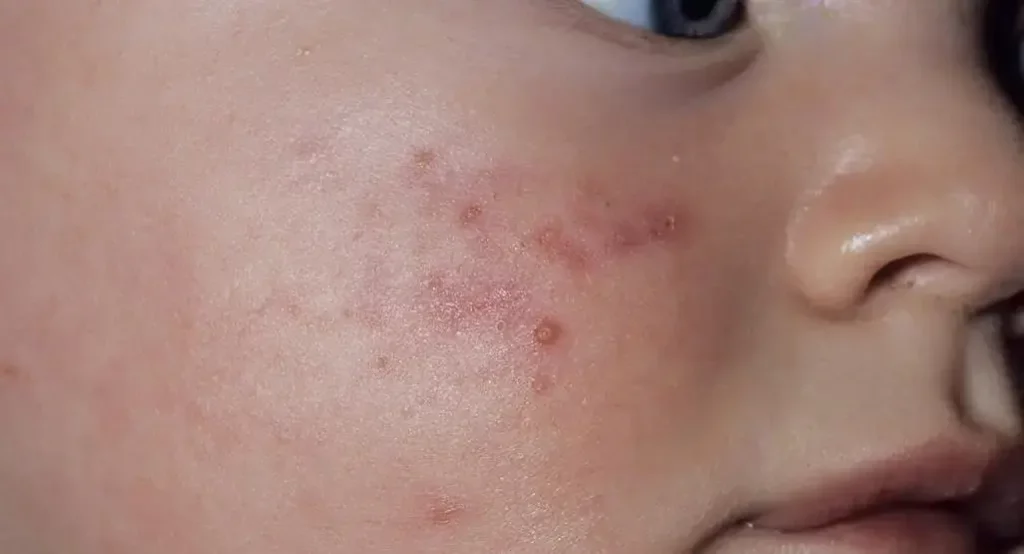
Baby acne may be present in your baby at birth or may show up before your baby is 3 months old, called neonatal acne, after 3 months old and above is called infantile acne. Baby acne looks similar to adolescent acne or adult acne.
It can be hard red or white bumps surrounded by inflamed skin. These bumps may develop white pimples or whiteheads and blackheads. In most cases, baby acne seems hard to identify.
It can look similar to other skin conditions like rash, Eczema, Erythema toxicum, cradle cap and contact dermatitis. How do you differentiate them? Continue to discover.
How do you differentiate baby acne from a Rash, Eczema and Erythema toxicum?
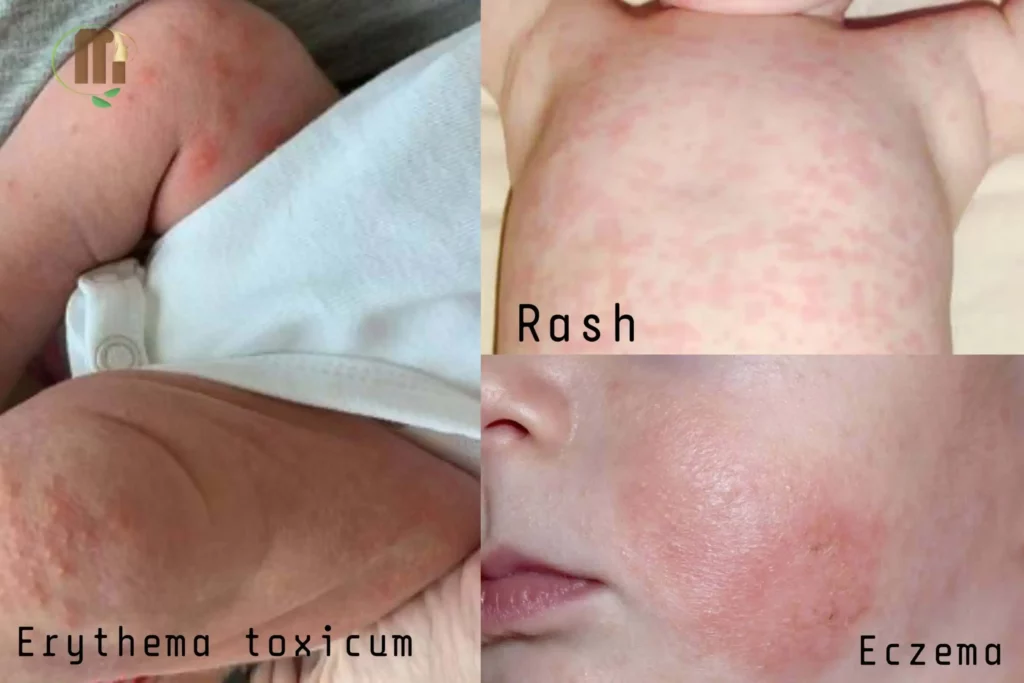
When I said baby acne looks like a red bump, it might also be suspiciously described as a rash. This has proven so difficult and tricky to differentiate.
How do you know it’s baby acne, not rash? Just like O’Neil says, Neonatal and infantile acne are both considered rashes.
Some other skin conditions like eczema, erythema toxicum, contact dermatitis and heat rashes are also mistaken. Here, let’s explain these conditions to help you differentiate them.
Eczema: Eczema can be described as dry and flaky skin irritation with areas of red irritations. It is not common in newborns but can be common from 2 to 4 months old.
It normally appears on the creases of the elbow, knee, chest and scalp. Eczema can become infected if not properly cared for.
Eczema generally won’t cause bumps, just like baby acne does. Your doctors easily distinguish it and can be treated with Aquaphor and Vanicream, but always consult a doctor for a prescription.
Erythema toxicum is another common skin condition that appears like a rash, tiny bumps or red blotches. This skin condition is harmless and tends to disappear over time. Erythema toxicum can be seen on this baby’s face, limbs or chest.
Heat Rashes: As the name implies, heat rashes occur in hot weather. It appears on that part of your baby’s skin that gets hottest or is always covered.
The back, armpit, feet, wrists, and neck are such areas. You can differentiate this from baby acne because baby acne does not really appear on the areas mentioned in the body.
Contact dermatitis: This skin irritation mostly appears when your baby’s skin comes in contact with something irritating. They appear as red bumps or flat red areas and can clear off when the irritants are removed.
An example of this is diaper rash, and it can be resolved by not letting your baby’s diaper overstay and using a diaper cream or ointment.
Cradle cap: This small reddish bump forms on the baby’s head or neck. It usually forms a crown and appears crusty or rough. This can cause the skin to flake off, in order words called dandruff. Differentiating cradle caps will be easier now with baby acne.
Explaining these common skin conditions mistaken with baby aches will help you differentiate and know your baby’s skin condition and find possible solutions.
What causes Baby acne on the Face?
The causes of baby acne are still unclear, and doctors haven’t gotten the 100% result of the causes but in rare cases.
Some things that cause these babies’ acne include the mother’s hormones in the womb or through breastfeeding. Mind you, and this shouldn’t affect how you breastfeed your baby.
Hormones in the placenta can affect the sebaceous gland of your baby during birth. When the sebum is largely produced, it can cause baby acne.
Another theory of the baby feeding formula may contain some active ingredients which, when in contact with the skin through vomit or other means, might cause baby acne on your baby’s face.
Yeast is another likely cause of baby acne. Some yeast that lives on your baby’s skin, such as Malassezia species, colonizes the skin, which can cause the skin to inflame, developing baby acne.
As some medical professionals theorized, the imbalance of prebiotics, helpful bacteria in the stomach, can also cause acne. Some medications administered to your baby due to one illness or the other can also cause an acne breakout.
No matter the cause of your baby’s acne, rest assured that our baby acne treatment tips will help you eliminate the acne in no distant time. Discover the baby acne treatment below.
Baby Acne Treatment
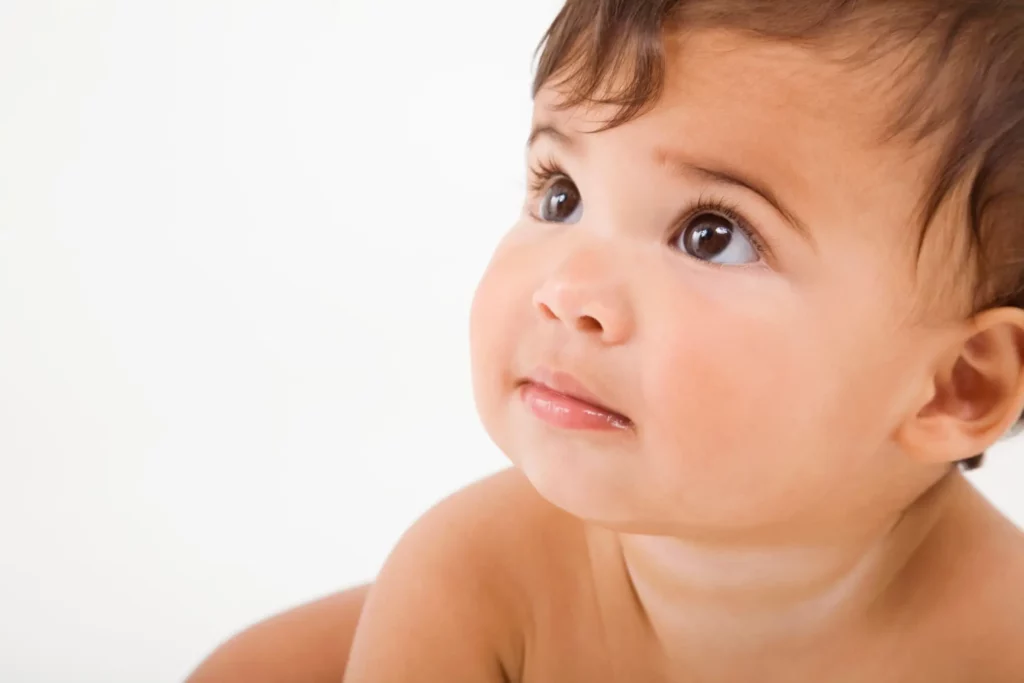
How can baby acne be treated? Well, you will get all the tips in no time. Treating baby acne can be a delicate concern, but with these tips treating your baby’s acne will be at your fingertips.
Baby acne mostly disappears without treatment, but some seem stubborn. Using just any ointment, lotions, over-the-counter acne treatment creams and face washes will cause more acne and harm your baby’s skin. Remember your baby’s skin is sensitive and should be treated gently.
Acne treatments used for adolescents and adults harm your baby, be mindful! Your baby’s pediatrician prescribes suitable medication creams; if not, these tips will help your baby’s acne treatment. Let’s get started.
#1. Cleanse your baby’s face and body with mild cleansers
Keeping your baby’s skin under control and care can help with your baby’s acne treatment. Cleaning the skin with a warm bath (not a hot bath) or a mild cleanser specially formulated for newborns.
Washing the skin with warm water is also very fine, but remove all jewelry pieces from the hand.
#2. Avoid rubbing off your baby’s skin
Many people are used to rubbing off their baby’s skin with a towel after a bath. I’m afraid that’s not right. Stop it today.
This can cause further skin irritations. After bathing your baby, learn to path the skin dry gently. This also applies to people using a towel or rough fabrics to bathe newborns; using a soft foam or bare hand is wrong.
It is also necessary to dress your little one in super soft dresses, and rough fabrics should be kept far from your baby.
#3. Avoid lotions or oily creams on your baby
Clogged pores, either oil or dirt buildup, cause acne. This makes oily lotions a bad idea for your baby’s skin. Instead, visit a pediatrician for a good baby moisturizing lotion specially formulated for sensitive and reactive skin.
#4. Never pick at bumps
Acne might pop on your baby’s face, and you will be tempted to pick them. Before you do that, let me expose you to the risk.
Picking or breaking your baby’s skin will leave the inner skin unprotected, therefore getting infected. Also, picking your baby’s bumps can cause scars or spots, leading to more breakouts. I’m sure you wouldn’t like that, resist the urge to pick bumps today.
#5. Breast milk remedy
Breast milk remedy is another treatment method many moms believe in and swear on. Although no research has proven this, breast milk contains high antimicrobial properties that can help keep your baby’s skin healthy.
Trying breast milk remedy might work for your baby, while doing this as a mom, be very mindful of the things you eat, your own diet should be healthy enough for your baby.
#6. Keep your baby’s skin away from irritants, rough fabrics, floors etc.
Your baby’s hygiene should come first to you as a mom, always keep your baby’s environment clean, which is the best way to keep your baby away from irritants.
Perfumes and other harsh deodorants can also irritate your baby’s skin; use a natural fragrance or avoid perfumes while nursing your baby.
Above all these baby acne treatment tips, always remember that patience is a virtue. None will work like magic, and it takes time to visualize the result.
Your comfort should lie in the fact that these acnes don’t cause harm to your child or discomfort them. It is better to take your time rather than use the wrong product.
FAQ
How do you clear up baby Acne?
Baby acne varies from baby and skin type. Some clear up on their own without treatment, while some prove hard to clear up.
To help speed up the clearing process, maintain your baby’s hygiene by cleaning with a mild soap or cleanser formulated for kids of her age, removing possible irritants from your baby’s surroundings, avoiding oily lotions and creams, avoiding using over-the-counter acne treatments, except for one’s prescribed by the pediatrician.
Above all, maintain a clean and conducive environment for your baby.
Can Breast milk help your baby’s acne?
Any research or scientific studies do not prove this process. However, some moms have sworn that breath milk helps their baby’s acne.
Whatever the cause, always maintain healthy breastfeeding for your baby. Is baby acne painful for the baby?
Not baby acne does not cause discomfort to your baby. If, in any way, your baby feels pain over any breakout, then you need to see a doctor immediately for further diagnosis and control.
In conclusion
Baby acne treatment does not require much. Just simple hygiene maintenance and good feeding can help your baby’s skin. This post has given you the necessary knowledge to care for your baby’s skin.
If your baby’s acne results from a concern, consult a doctor immediately for further consultation. Always remember, “Patience” is a virtue to possess when it comes to baby acne treatment, your baby’s skin is very much more tender than yours, just follow these provided tips and see your baby’s skin back to glowing as usual.
Glow right!




